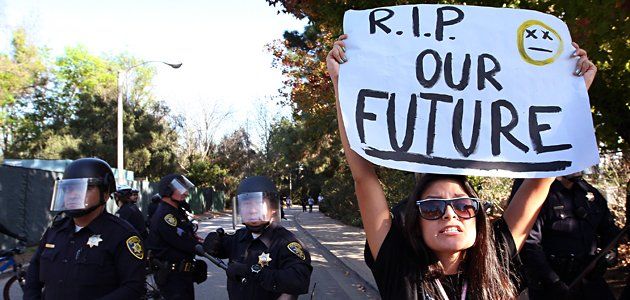
Faced with a $19 billion budget deficit this spring, California Gov. Arnold Schwarzenegger announced that he was taking a cleaver to state health and welfare programs for the poor, the disabled, and the elderly. And rather than removing another slice from the state's vaunted higher education system—which had already experienced years of reductions in state aid, ensuing tuition hikes, and student protests in response—budget cutters took more than $1 billion out of the state corrections programs, particularly prison health care.
It may seem odd that state funding for college kids often competes with money for prisoners, but if you track spending in California over the past 30 years, you'll see evidence of a long-standing tug of war between these two very different constituencies. Over much of the past decade, funding for corrections has gone steadily up, while spending on state colleges has tumbled. "The state seems to be saying we have more of a future in prisons than in universities," University of California president Mark Yudof said in a recent speech.
Following months of protests by students, parents, and colleges, Schwarzenegger urged the California legislature to pass a constitutional amendment earlier this year that would require the state to spend more on college classrooms than prison cells. "What does it say about any state that focuses more on prison uniforms than on caps and gowns?" Schwarzenegger said, adding that "30 years ago, 10 percent of the general fund went to higher education and 3 percent went to prisons. Today, almost 11 percent goes to prisons and only 7.5 percent goes to higher education. Spending 45 percent more on prisons than universities is no way to proceed into the future." The state's priorities, he added, "have become out of whack."
While his proposal hasn't succeeded in securing serious political traction, Schwarzenegger's words are clearly having an impact on voters. When the Public Policy Institute of California recently conducted a poll asking where state government should be trimmed, most respondents said no to more cuts for higher education, and overwhelmingly said yes to trimming the corrections budget. But maybe that was because all the talk about prisons versus colleges confused voters, says Thad Kousser, an associate professor of political science at UC San Diego. The PPI study also found that 49 percent of those polled had the mistaken impression that California was spending more on corrections than anything else. "Prisons are not this mammoth thing that is eating up the rest of the budget," he says.

The 11 percent that California is spending on corrections is higher than the national state average of 7 percent, and the Golden State's university system is one of the most extensive in the country. So it may not be surprising that nowhere else in the country is the faceoff between prisons and higher education so stark. However, it is also true that 30 states have already slashed their higher-education budgets in response to recessionary pressure, and there's every reason to think more cuts will be coming. (A recent report by the National Governors Association [NGA] predicts that states may not regain their fiscal footing until the end of the decade.)
Most states have a commission or committee looking for ways to reduce their budgets, and there's not much maneuvering room, partly because of rising corrections and health-care costs. Those two, says John Thomasian, director of the NGA's Center for Best Practices, are "sucking the wind out of any discretionary funding" states had. Most states spend most of their money on K–12 education, but that's also the least popular place to cut, he says.
As a result, higher education is the budget item that ends up being particularly vulnerable. "When times are good, states put more money into it, because they know it's their economic engine," says Thomasian. "But there is no constitutional requirement to fund higher ed." Governors and legislatures know that they can "let tuition make up the difference" so they treat their state colleges and universities as "a fiscal balance wheel," acknowledges Terry Hartle of the American Council on Education. It doesn't help, adds Thomasian, that many state leaders think university systems aren't managed as efficiently as they should be. "They are not viewed as one of the most productive areas of our economy," he says. "More money doesn't produce better students or higher graduation rates."

But that doesn't mean that there isn't pressure building in many states to find smarter ways to cut corrections costs. In California, for instance, two thirds of state-prison admissions are related to technical parole violations, Thomasian says. Yet research shows that parole compliance is better when convicts are hit with immediate sanctions (like a weekend in a local jail) than if they are eventually sent back to prison. Electronic monitoring devices, which restrict convicts' geographic movements, are also getting more consideration. Both ideas require more state investment in parole and probation supervision, but in the long run, Thomasian says, they will save money and lives. "When people are behind bars, they are not paying child support or paying taxes," he says. "It's also a fact that after someone spends two years in prison, they are lost, even if they came in as a nonviolent offender. Total immersion in that kind of culture leaves its mark."
Imprisonment is also very expensive. In California, the cost of keeping an inmate behind bars for a year is about $52,000, similar to the cost of tuition, room, and board at Stanford University. Among the reasons for that high price tag: California has the best-paid prison guards in the country and their union's political muscle has helped ensure that corrections jobs kept growing over the past three decades. As the state budget crisis has escalated, however, there's been more of a push by reformers to consider ways to whittle down the prison population by reducing sentences, easing penalties for parole violations, or releasing some prisoners (particularly the elderly and sick) early. But experts say such proposals are politically risky.

"Politicians are well aware of the political price to be paid if someone they let out early goes on to commit a serious crime," UCSD's Kousser says. "You can have an overall 99.9 percent success rate, but one person re-offends, and it can become a political nightmare for anyone who backed it." The recent Chelsea King murder has reignited the debate in California over proposals to change tough sentencing laws.
As a professor at a public university himself, Kousser says he'd like nothing better than to see corrections costs shrink and higher education funding rise, but he doesn't think it's politically feasible to cut corrections drastically—at least not in a state like California that has a "huge law and order vote." The bottom line, says Kousser, is that "no one wants to overspend on prisons, but people expect the state to make their safety a top priority."
Ultimately, it may not make much sense to link spending on higher education and money allocated for corrections. "Inmates and students both tend to be young, and like colleges, prisons are residential facilities, but I'm not sure it makes sense to compare them," says Hartle. "No reasonable person would disagree that spending money on education is a more constructive, lifelong investment. But just like everyone else, I also want every criminal who might harm me or my family to be locked up."
Find out more about the social and economic impact of America's prisons in our series. Read about how the recession is slamming private jails, and find out why we should treat drug addicts in prison.
Uncommon Knowledge
Newsweek is committed to challenging conventional wisdom and finding connections in the search for common ground.
Newsweek is committed to challenging conventional wisdom and finding connections in the search for common ground.
About the writer
To read how Newsweek uses AI as a newsroom tool, Click here.





